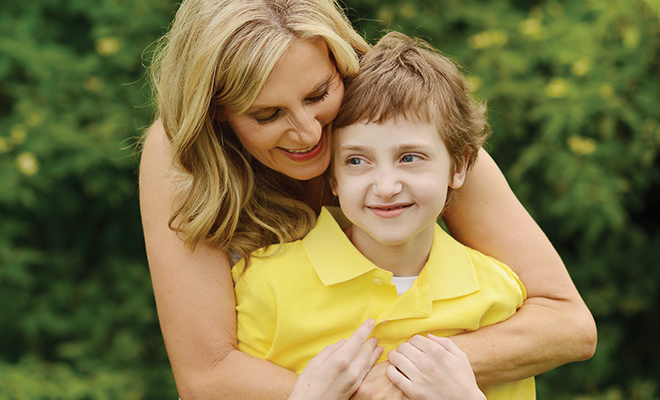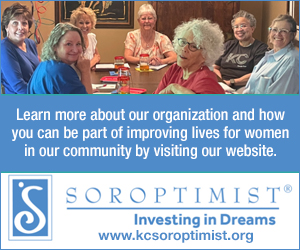 Heather Morrow
Heather Morrow
Making a Difference through Braden’s Hope
When you’re shopping for clothes for your children, you don’t walk into the men’s or women’s section looking for something. In addition, you would never give an adult dosage of medicine to a child for fear of the negative reaction they might have to it. Nor would you administer a drug designed for an adult to a youngster. Or would you? What if it was the only course of treatment available?
That’s the issue Deliece Hofen has struggled with for years as she and her husband have sought treatment for the cancer that is killing her son, Braden. In 2007, Braden was diagnosed with neuroblastoma, a solid mass tumor. At that time, Braden’s cancer was at a frightening Stage 4, and he was left with a 30 percent change for survival past five years.
“After treatment, we thought we had it beat but just three months later he relapsed. He went in for more treatment, and we thought we had it beat again,” the Olathe, Kansas, mother recalled. “But he relapsed once more, this time with leukemia. Ironically, the leukemia was brought on by one of the earlier cancer treatments he had received.”
Unfortunately, few treatment options are available to kids because their cancer is underfunded and overlooked. Deliece points out that only three and a half percent of the budget from the National Institute of Health is directed toward research to develop treatments and eventual cures for cancer in children. Because so little is known about childhood cancer, adult cancer drugs are used, which were not created with youngsters in mind. But with that treatment can come an agonizing payback as additional medical issues may arise from using drugs intended for adults that are administered to children. Braden’s leukemia is an example of the negative impact adult cancer drugs can have on children.
Even though the disease is called cancer across all age groups, it varies considerably because of the makeup of our bodies. Scientists are proving in many cancers that the childhood version is different than the adult version at a cellular level. Yet a child must be treated with adult cancer drugs because that’s the only choice available. Deliece notes that since 1980 only one drug has been developed for childhood cancer treatments, while in that same time frame more than 50 have been created for adults. Deliece knows this well, not only with Braden, but through her own cancer struggle as well.
At the same time Braden was going through his relapse with cancer, Deliece was diagnosed with Stage 2 breast cancer. However, it was a much different scenario. Significantly more treatment options were available for her as compared to what was offered for Braden. Deliece was able to beat her cancer. “Going through that showed me a change had to be made in the treatment of childhood cancer, just as it had been done for breast cancer,” remembered Deliece. “That’s when I decided to organize Braden’s Hope. Our goal is to create awareness and increase funding for the research so desperately needed to find cures for childhood cancers.”
Braden’s Hope For Childhood Cancer is a 501(c)(3) concentrating on raising awareness of cancer in children and fundraising to underwrite research grants at hospitals or research institutions in the amounts of $100,000. The group focuses on awarding these large grants rather than smaller amounts because it makes a huge difference in gaining matching grant dollars. Monies given by Braden’s Hope and other charities are viewed by the National Institute of Health as “seed money,” increasing the chance it will contribute to these research efforts. The institutions that have received awards from Braden’s Hope are leaders in childhood cancer disease research: Children’s Hospital of Philadelphia, Philadelphia, Pennsylvania; Dana-Farber Cancer Institute, Boston, Massachusetts; Texas Children’s Hospital, Houston, Texas; and Cincinnati Children’s, Cincinnati, Ohio. Locally, grants have gone to KU Medical Center and Children’s Mercy.
“Childhood cancer is the number one killer by disease among children, yet it is very overlooked and underfunded,” remarked Deliece. “Large organizations such as the American Cancer Society do a lot of good for a lot of people, and we’re grateful for those efforts, but they contribute a very small percentage to childhood cancer research. The statistics show that only about a half of a penny from every dollar raised by the ACS goes to childhood cancer research.”
With Braden’s Hope and a lot of help from Deliece’s friends and family, this organization is striving for the day when no child or family will ever have to hear the words “no known cure.” Every child battling cancer deserves a chance to fight and win, and Braden’s Hope is leading that charge. “We’re really focused on raising money for targeted therapy for children’s cancers,” stated Deliece. “No one gets paid. The agency is run right here from my kitchen table with the help of some very awesome friends. Only two and a half percent of our total budget is spent on costs, and the rest goes right to our mission.”
After just four years, Deliece has made good on her dream. More than $300,000 in grants has been awarded and the goal is for $200,000 to $300,000 in grants for this year. The major fundraising event is the Hope Gala, which will be held on September 26, 2015, at the Overland Park Convention Center. Tickets can be purchased at the website, bradenshope.org. Last year, the team brought in $176,000 through ticket sales and a silent and live auction.
Another important fundraiser is printed calendars, and every month a local pro athlete is paired with a childhood cancer kid. Not only does it bring in additional dollars, but it creates awareness and educational opportunities for each month. “Sometimes kids will come up with their own ways to make money, such as setting up a lemonade stand,” stated Deliece. “It doesn’t matter if it’s $12 or $12,000; those efforts are so powerful because these kids have taken it on themselves to help other kids.”
Not only is Braden’s Hope raising dollars for research, the organization is also committed to raising awareness of childhood cancer, especially in the medical community. Educating physicians about childhood cancer may help them diagnose the disease earlier when it’s much easier to treat. At this time, 80 percent of kids with cancer aren’t diagnosed until they’re in Stage 3 or 4. Only 20 percent of adults are first diagnosed at these stages. Every day 48 children are diagnosed with cancer, and seven die each day from this disease.
But ten-year-old Braden is one of the lucky ones, into his third remission. Along the way, he’s received new treatment regimens, helping pave the way for other kids. On July 8, 2013, he was diagnosed with leukemia, more than likely caused by some of the adult treatments he was forced to use. But doctors suggested trying a bone marrow transplant, offering healthy donor cells to his body. His 12-year-old brother Zach was a perfect match, and he readily stepped up to the plate on March 30, 2014, in hopes that this time Braden’s cancer would be beaten.
“Kids with cancer are the bravest people I’ve met in my entire life. They’re strong and courageous, but they’re also scared and they need our help,” noted Deliece. “This story has a lot of tentacles but that’s the Braden’s Hope story.”
Deliece, along with many others, believes that childhood cancer can be cured if funding is available for completing vital research. At this time, researchers don’t have the finances to test the theories they have. In many cases, they run out of money before fact-finding trials can be finished. But Braden’s Hope can make a significant difference in treating cancer and helping kids live longer lives.
“I don’t know what the future holds for Braden, and I can’t tell you what the next hour or next day might bring us. Three times doctors told us he wouldn’t make it, and we’re still here and, as of today, we have hope that we might find a treatment that’s going to cure him,” remarked Deliece. “During our journey, I’ve found that it’s about how you live your life and appreciate every moment, prioritize every heartfelt piece of hope. Yes, I don’t know what tomorrow holds for our family, but I know we’ll face it with a positive attitude and make the most of it. That’s what we’re doing with Braden’s Hope.” HLM
Learn more about the upcoming gala and how you can help at bradenshope.org.









